
|
Sale 34
Pre-Long Beach Coin and Currency Auction
| Lot |
Photo |
Description |
Realized |
Lot 468 |
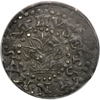 |
1662 Oak Tree Twopence. PCGS graded EF-40. Toned. According to Breen, at least 4 stages of reworked dies were used to strike the large 2 variety. The date is distorted looking on these. Curiously the "oak tree" designation dates back to at least 1662. In an instance of political daring, since these were disallowed by the King of England, Sir Thomas Temple in that year showed King Charles II one of these oak tree pieces, said to be a shilling, identifying it to His Majesty as the oak tree at Boscobel in which the fugitive king had hidden from Cromwell's soldiers in 1651. At which the King, in good humor, called the colonists "a parcel of honest doggs" rather than order reprisals for treason! Pop 15, 31 finer (PCGS # 17) .
Estimated Value $5,000 - 6,000.
View details and enlarged photos
Check results on similar lots
| Unsold |
Lot 469 |
 |
1652 Oak Tree Shilling. PCGS graded AU-53. Well struck and well centered. A remarkable example with lovely natural antique toning. There are a few slight marks in the upper branches of the oak tree, but generally the surface is excellent, indeed, outstanding for this very early silver colonial coin. On this variety of Breen-21, we see the N in IN reversed; there is a strong tree which has a double trunk; OM is directly below the XIII and crowded together. A wonderful opportunity for the Colonial collector! Pop 6 with 12 finer (PCGS # 20) .
Estimated Value $14,000 - 16,000.
View details and enlarged photos
Check results on similar lots
| Realized
$20,125 |
Lot 470 |
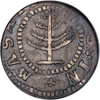 |
1652 Pine Tree Shilling. Small planchet. PCGS graded EF-40. Nice even grey toning. This is the small planchet variety of the Pine Tree design. Sleek "old silver" patina of medium-deep gray with a little steel blue iridescence at the margins. Curiously, the earliest pine tree coins were minted on the same size planchets as the oak tree pieces. Subsequent issues of the shilling were narrower and thicker to conform to the size of the English coins. A very popular Type struck in Massachusetts Colony. Pop 30; 24 finer (PCGS # 24) .
Estimated Value $4,400 - 4,800.
View details and enlarged photos
Check results on similar lots
| Unsold |
Lot 471 |
|
1652 Pine Tree Shilling. Small planchet. PCGS graded VF-35. 69.4 grs. Small obverse letters, date and denomination tucked up against the upper border of dots leaving the most space below the XII. Light to medium gray with deeper charcoal-colored gray around the devices.
The shift from the Oak Tree design to the Pine Tree was a measured process. What is taken to be the final Oak Tree variety is known as the "spiny branches" variety (Noe 14) and looks very much like the Pine Tree. Also, Oak Tree sixpence coins in the varieties Noe 20 through Noe 22 use the same reverse die as the Pine Tree sixpence, Noe 32. It is generally thought the change to the Pine Tree design occurred in 1667 when the first renegotiated minting contract expired and a new agreement was signed. However, there is no proof for this, nor can we be sure that the production of Oak Tree coins ceased before Pine Tree coins began.
In relation to the earlier styles, a vast number of Pine Tree coins were minted. The shillings come in two different series. The first series of Pine Tree shillings, made on large thin planchets, were produced using the same technology as was used for the Oak Tree series (either a rocker arm press or a roller press). The second and final series of Pine Tree shillings were struck on smaller and thicker planchets than the previous series. This was due to the replacement of the rocker arm or roller press by the more sophisticated screw press. In the screw press, an upper and a lower die are pressed together by turning handles attached to a large screw. Hence, the more consistent quality of these small planchet pieces (PCGS # 24) .
Estimated Value $2,500 - 3,500.
View details
Check results on similar lots
| Realized
$3,910 |
Lot 472 |
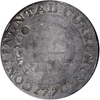 |
1776 Continental Currency. "CURRENCY". Pewter. PCGS graded VF-30. Very popular coin. Nice details for the grade. Grey toning. This is a pleasing, original and uncleaned example with exemplary outer design including full date and legend, but the centers are not quite fully struck, with a region of weakness found on the sundial. However, the reverse central legend is suitably clear. Struck in pewter, which has a dullish dove-gray patina when toned, although we find traces of original silvery luster within the letters. These little sparkling effects can be made out in the photographs and point to the relative lack of wear on the piece.
These are sometimes referred to as Continental "Dollars" although there is no explicit denomination on the coin. Some students of numismatic arcana point to its size as being close to the proposed measure for the one-cent piece of the period (the 1792 Birch cents being an example). Whatever its true origin, the Continental Currency pieces are great rarities and a clear link to our nation's founding (PCGS # 794) .
Estimated Value $17,000 - 18,000.
View details and enlarged photos
Check results on similar lots
| Realized
$19,550 |
Lot 473 |
 |
1787 Fugio Cent. Club rays, rounded ends. VF-20. Perhaps even sharper than our Very Fine designation. Dark brown with slightly rough surfaces. A high grade example of the scarcer "with club rays" type.
Estimated Value $1,250 - 1,750.
View details and enlarged photos
| Realized
$978 |
Lot 474 |
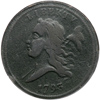 |
1793. Bent cap, type 1. PCGS graded Fine-15 Brown. The surfaces are porous as usual, and a shade of dark steel brown. The details are clear and visable, however, with clear date and most legends readable. A popular type coin for our first half cent coin. What's more, there were only 35,334 minted. Variety Breen-1502 with no periods after AMERICA and CENT; short ribbons and stems (one of two die varieties comprising the majority of the 1793 mintage) (PCGS # 1000) .
Estimated Value $3,500 - 4,000.
View details and enlarged photos
Check results on similar lots
| Realized
$5,750 |
Lot 475 |
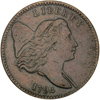 |
1794. ANACS graded Fine-15 Brown. VF Details, Net Fine 15 choice planchet. Reverse damaged by some surface digs and dents around HALF CENT, etc. Light chocolate brown to steel brown in color. A few marks in the reverse. Breen-1507 with knobbed 9 in date and date low in the field, nicely following the rim (PCGS # 1003) .
Estimated Value $650 - 750.
View details and enlarged photos
Check results on similar lots
| Realized
$978 |
Lot 476 |
 |
1797. Plain edge. ANACS graded Very Fine, Net Fine-15. Minor rim cuts and cleaned. A pleasing coin for this issue despite its minor drawbacks. Breen-2a, centered head, knobbed 9 in date.
Estimated Value $650 - 750.
View details and enlarged photos
| Realized
$805 |
Lot 477 |
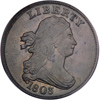 |
1803 Draped Bust Half Cent. PCGS graded EF-45 Brown. Breen-1 which has 5 berries on the left branch and a wide fraction, including a die line from the fraction bar to the right ribbon (a common variety). Rather flatly struck on the hair waves, reducing their sharpness. Rich chocolate brown. Pop 12; 34 finer. (PCGS # 1060) .
Estimated Value $600 - 650.
View details and enlarged photos
Check results on similar lots
| Realized
$805 |
Lot 478 |
 |
1806 Draped Bust Half Cent. Large 6, stems. Breen-4, C-4. MS-60 Red & Brown. Rotated rev. Traces of mint color in the protected areas. Lovely steel brown to gray brown patina in the main areas of the field. Belief was that this large 6 variety was struck in 1807. The 6 of the date is firmly implanted in the bottom of the drapery. Available, but only because of an old Chapman hoard from long ago; these tend to be weak at the top of the wreath.
Estimated Value $800 - 900.
View details and enlarged photos
| Unsold |
Lot 479 |
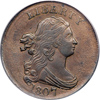 |
1807 Draped Bust Half Cent. PCGS graded MS-62 Brown. Usual die state with weak border denticles. Light brown with steel brown highlights on the smooth cheek and hair, as well as Liberty's shoulder and leaf topes. Only the 1 die variety this year from a production of 476,000! Pop 8; 4 in 63BN. (PCGS # 1104) .
Estimated Value $1,500 - 1,600.
View details and enlarged photos
Check results on similar lots
| Realized
$4,140 |
Lot 480 |
 |
1808 Draped Bust Half Cent. 8 over 7. PCGS graded VF-30 Brown. Dark steel brown with porosity and several deep marks. The 1808/7 overdate half cent in is very scarce, and if you fail reach for it, even in this modest grade, and even above current market levels, you may have to wait months before you have the opportunity to acquire another specimen. PCGS has graded only 36 in total. None in mint state (PCGS # 1110) .
Estimated Value $1,500 - 1,800.
View details and enlarged photos
Check results on similar lots
| Realized
$2,070 |
Lot 481 |
 |
1810 Classic Head Half Cent. PCGS graded AU-50 Brown. Only the one variety (Cohen-1), most of the reported mintage of 215,000 was struck in 1809. Dark to medium brown, somewhat granular appearance from the heavy metal flow lines in the fields. Pop 2; 30 finer. (PCGS # 1132) .
Estimated Value $600 - 650.
View details and enlarged photos
Check results on similar lots
| Realized
$1,150 |
Lot 482 |
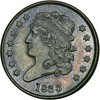 |
1833 Classic Head Half Cent. Proof 63 Brown. Attractive iridescent toning. A handsome proof 1/2 cent. Cohen-1 variety with mainly steel-brown to blue-brown surface and an interesting die crack through many of the stars to the left of Liberty. Scarce!
Estimated Value $2,500 - 2,750.
View details and enlarged photos
| Unsold |
Lot 483 |
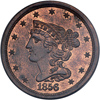 |
1856 Coronet Head Half Cent. PCGS graded MS-64 Red & Brown PQ. Well struck. The surfaces are slightly reflective and there are only a couple of areas of deep toning found. A lovely coin. Pop 26; none finer in RB at PCGS. (PCGS # 1237) .
Estimated Value $600 - 700.
View details and enlarged photos
Check results on similar lots
| Realized
$1,323 |
Lot 484 |
|
A collection of Half Cents. 1794 thru 1855. A collection of 18 different dates grading Poor to Almost Uncirculated. A must view lot. Lot of 18 coins.
Estimated Value $900 - 1,100.
View details
| Realized
$1,898 |
Lot 485 |
 |
1793 Flowing Hair Cent. Chain reverse, "AMERICA" in legend. PCGS graded VF-35 Brown. Close date, no periods. Easily recognized variety inasmuch as it has a "leaning R" in LIBERTY. The surface is pleasing dark brown to steel color, with a few wispy hairlines, two tiny rim bruises on the obverse (one is at 9 o'clock, while the other is below the date). The centers are extremely well struck for this key first year of issue, and display outstanding hair on Liberty as well as strong interlinked chain elements on the reverse. Only 36,103 large cents were made of the Chain type, and these tended to get heavily abraded in circulation due to the soft copper (PCGS # 1341) .
The first reverse die for 1793 had the word "AMERI" instead of "AMERICA" because it was thought more important to have a balanced reverse legend than to have the name spelled out. The idea was quickly dropped once mint personnel realized that the name of the country should not be abbreviated.
The first cents, as all coins struck at the Mint through the early days of 1795, were hand-fed into the press by a young boy; there was as yet no automatic feeding mechanism triggered by the operation of the screw press. Only one hand-operated press was used for the Chain cent coinage in 1793, but by early in 1794 two presses were occasionally in operation at the same time, hence the increased production that year versus 1793.
Estimated Value $30,000 - 38,000.
View details and enlarged photos
Check results on similar lots
| Realized
$43,700 |
Lot 486 |
 |
1793. SEGS graded Wreath Type EF-40. Obverse and reverse planchet voids/ lamination. The surfaces are porous and black yet with nice details in spite of this. Clear date digits. This is Sheldon-11c, a Type that involves three variants in the edge device, which has a Vine and Bars design. "Planchets often defective", notes Breen, as seen here, partially the result of time, possible burial and the elements, but also due to bad planchets in the first place.
Estimated Value $2,500 - 2,800.
View details and enlarged photos
| Unsold |
Lot 487 |
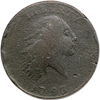 |
1793. Chain reverse, "AMERI." in legend. SEGS graded VG-10. Micro porosity throughout, with very weak legends but a plain enough Liberty head and chain to identify it. Dark blackish brown patina as though buried in the ground for many years. Sheldon-1. Micro porosity. Popular chain cent type.
Estimated Value $4,500 - 5,000.
View details and enlarged photos
| Realized
$5,463 |
Lot 488 |
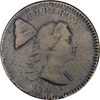 |
1794. "Head of 1793". ANACS graded Fine-15. Corroded-burnished. Nice steel brown color with much detail.
Estimated Value $1,700 - 2,000.
View details and enlarged photos
| Realized
$1,955 |
Lot 489 |
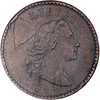 |
1794. "Head of 1794". NGC graded EF-40 Brown. When a coin collector hears the term Starred Reverse, only one image comes to mind: This rare Sheldon-48 1794 is one of the most well-known of all large cent varieties, even among those collectors who do not specialize in these handsome big copper cents. Of course, to the large cent enthusiast, this is a variety of unending popularity and desire. In Penny Whimsy, Dr. William Sheldon observed that "collectors mention it [the Starred Reverse] with religious awe." The numismatic mystery to solve is exactly why the stars on the reverse of this variety? Sheldon believed "they are put in with a light punch, and since they are far too light to have been intended as a border, it is perhaps more likely that they are the result of the whim of an idle hour at the Mint." There are 94 of them. The number of stars are connected to the year of the coin, it seems, but their rationale has yet to be explained.
This is one of the finer examples of this variety, a sharp NGC graded EF40. The obverse has medium steel to purplish brown with a few light hairlines including several through the lower bust, one crossing the face and nose to the rim; there is a tiny rim bruise above the cap and another two, smaller bumps, at the end of the pole and about the 3 o'clock position on the obverse. The date and LIBERTY are sharply impressed into the planchet, as is the main portrait with cap, showing all of the intricate hair curls, with only the topmost curls merged through normal circulation wear. The cheek is well rounded.
On the reverse, the color shades from light granular reddish brown all the way through steel iridescence and gray, with a few light marks and hairlines, plus weakness in some of the lettering of UNITED STATES OF AMERICA. The wreath, too, is lightly impressed by the die, but all leaves show plainly or are visible. The key elements of this rare variety, the 94 tiny stars, are laid out around the periphery within (and sometimes overlapped by) the thick points of the edge denticles.
At this grade level, the 1794 S-48 starred reverse is a landmark offering for the specialized collector. Pop 1; finest graded by NGC. Only a total of 4 graded at NGC.
This variety, with its 94 tiny stars within the denticles on the reverse, was discovered in 1877 by Henry Chapman in the presence of Dr. Maris and S.H. Chapman. The story of the discovery was recounted in 1926 by S.H. Chapman in his book, "United States Cents of the Year 1794".
Pete Smith, who has devoted a significant amount of time and effort to researching the 1794 Starred Reverse Cent, tracked 41 examples of this variety in 1986 and 56 examples in 2004. The finest S-48 examples grade variously from VF-35 to EF-45 depending on opinion; Early American Coppers collectors tend to be less forgiving with a large cent's grade. That is why you'll often see dual grading by an EAC cataloger, the "official grade" and the EAC grade. Then too, being a technician, an EAC grader's descriptions often read like a Doctor Quincy medical autopsy rather than the free-flowing gush of words which this rare, high grade Sheldon-48 cent obviously deserves.
Estimated Value $60,000 - 70,000.
View details and enlarged photos
| Realized
$92,000 |
Lot 490 |
 |
1795. Plain edge. PCGS graded VF-25 Brown. Nice steel brown color. Very crisp detail for the grade on a problem-free planchet, making this 1795 Capped Bust coin ideal for a U.S. Type Set (PCGS # 1380) .
Estimated Value $1,000 - 1,200.
View details and enlarged photos
Check results on similar lots
| Realized
$1,323 |
Lot 491 |
 |
1797 Draped Bust Cent. Reverse of 1797, stems. PCGS graded Sheldon-123. MS-64 Brown. Variety with 12 berries in the wreath. From the famous "Nichols find" of 1797 cents, a popular coin that would make a wonderful addition to any collector's set. Lustrous steel brown with excellent detail. Well struck. Pop 25; 6 in 65BN; 2 in 66BN. The scuffs seen on the reverse are on the holder and not on the coin (PCGS # 1422) .
Estimated Value $7,000 - 8,000.
View details and enlarged photos
Check results on similar lots
| Realized
$12,075 |
Lot 492 |
 |
1814 Classic Head Cent. Plain 4. NGC graded AU-50 BN. Attractive dark steel brown with lighter reddish brown around the major devices and stars. A few old marks but generally quite choice for this issue. The large cents of 1808-14 were struck on unusually soft (pure) copper planchets, which tended to wear quickly in circulation; hence it is that few choice AU-50 examples like this are in collectors' hands. Pop 4; 14 finer in brown at NGC.
Estimated Value $1,500 - 1,700.
View details and enlarged photos
| Unsold |
Lot 493 |
 |
1821 Coronet Head Cent. NGC graded N-2 Wide Date, 8 Low Proof 63 Brown. Central portions including Liberty's hair is needle sharp. The surfaces are a uniform bluish mahogany in color with a few marks on Liberty's profile and a short line at the rim betweel stars 2 and 3. Glossy color, great depth of detail in the hair and stars, an impressive rarity that will have copper buyers champing at the bit to submit a bid. Pop 1 with 1 better.
Estimated Value $12,500 - 15,000.
View details and enlarged photos
| Unsold |
Lot 494 |
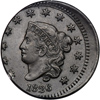 |
1826 Coronet Head Cent. PCGS graded AU-55 Brown. 10% off center. Mint Error. Glossy dark steel chocolate brown with more than just a little friction on the topmost hair curls. Quite an impressive Mint Error for this period in American coinage.
Estimated Value $2,500 - 2,750.
View details and enlarged photos
| Unsold |
Lot 495 |
 |
1831 Coronet Head Cent. NGC graded Proof 64 BN. Pop 3; 2 in Pf-65BN. Well struck. Nice shades of light Brown to gold toning. N-3, R.1. Brown and mint steel blue iridescence with rounded stars and moderately rounded date and lettering. The tops of the leaves and hair curls are lighter tan to golden brown against the deeper aspects of the glossy fields on both sides. The fields show evidence of having been struck from a polished die, but the resulting reflectivity is not comparable to later, mass produced Proofs of the 1850s and beyond, of course. Whether early Proofs were struck more than once by the dies, or struck on special equipment and not the everyday presses, is left to question. But without a doubt, this is a very rare item for the specialist to consider.
The Breen proof book (1977) lists 12 proofs from 1831 with "others reported." All are from the N-3 dies, as is this coin. His book has a photograph of the French-Clarke specimen. It, too, is incompletely struck on the peripheral stars but it appears the fields are bright and reflective.
Estimated Value $16,000 - 18,000.
Ex: French 503 Sale; T. James Clarke; Ted Naftzger; NERCA 11/79 lot 38; EAC '89 lot 321; D. Loring; E. Streiner.
View details and enlarged photos
| Unsold |
Lot 496 |
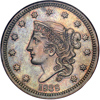 |
1838 Coronet Head Cent. NGC graded Newcomb-11. Proof 65 Brown. A lovely specimen of this rarity in Proof, don't let the photographs lead you astray. Our photographer's industiral-strength precision lens captures everything, including the fine hairline scratches on the grading holder, which is what those little lines in the photographs are. This coin is outstanding! A simple pleasure to examine and hold, a coin sharply made with only a few round-topped stars, and sure to please everyone with its steel brown and golden red iridescence. A very rare issue in Proof, with approximately 30 or so examples know to survive from these dies. A lovely coin for the advanced large cent collector! Pop 2; 1 in PF-66BN; 1 in 66-RB.
Estimated Value $10,000 - 12,000.
View details and enlarged photos
| Unsold |
Lot 497 |
 |
1841 Coronet Head Cent. PCGS graded Proof 64 Red & Brown. N-1, the only dies from which Proofs were struck this year. Breen (1977) notes that several of the Proofs of this year have fiery-red color. We suspect this one did too before cleaning as it still retains a fair amount with bright iridescent blue accents. Nice shades of red colors elsewhere. Somewhat blunt strike on the stars and point of the coronet as well as the back of the hair bun; corresponding light strike on many of the leaves in the wreath due to insufficient die pressure. A choice, glittering Proof of this early issue and a rare find for the Large Cent connoisseur. According to Walter Breen (1977), the Philadelphia Mint struck no more than a couple of dozen proof cents in 1841. Pop 8; 2 in 65-RB. (PCGS # 1953) .
Estimated Value $7,000 - 8,000.
View details and enlarged photos
Check results on similar lots
| Realized
$8,050 |
Lot 498 |
 |
1852 Coronet Head Cent. NGC graded MS-65 Brown. Glossy sleek steel brown to purple brown hue with a few hints of red. Pop 99 (PCGS # 1898) .
Estimated Value $575 - 625.
View details and enlarged photos
Check results on similar lots
| Realized
$489 |
Lot 499 |
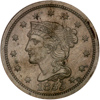 |
1855 Coronet Head Cent. PCGS graded Proof 63 Brown. Well struck with uniform mahogany brown color. One of the 100 proofs struck of the Slanting 5s variety. There is a tiny die chip noted at the front of the coronet, a diagnostic of the N-10 dies. The fields are also nicely reflective, but not as deeply mirrored as later, mass produced Proof coinage. The striking details are fully brought up, as one can only find on choice Proofs, and the rims are wide, even, and squared off. The medium to deep brown color in the centers turns to a lovely wood-grain texture at the margins. There is a small spot of carbon by the 13th star. Pop 3; 5 better. (PCGS # 1994) .
Estimated Value $3,700 - 4,000.
View details and enlarged photos
Check results on similar lots
| Realized
$4,370 |
Lot 500 |
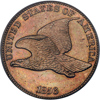 |
1856 Flying Eagle Cent. PCGS graded Proof 62 PQ. Well struck with lovely colors and simply outstanding sharp detail in the eagle. Mint designer-engraver James Barton Longacre reworked Gobrecht's soaring eagle of 1836-9 and placed it on the obverse of America's first Small Cents. These were first given the name "white cents" by the public and must have been strikingly brilliant and silvery when new compared to the old red Large Cents then being withdrawn. For the reverse Longacre adapted his first wreath of cereals design first used on Gold Dollars and Three-dollar. The 1856 issue is, of course, THE coin to buy if you can afford it. And in Proof condition, as represented here, it is an amazing beauty! (PCGS # 2037) .
Estimated Value $14,000 - 15,000.
View details and enlarged photos
Check results on similar lots
| Realized
$16,675 |
Lot 501 |
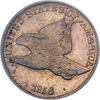 |
1856 Flying Eagle Cent. PCGS graded Proof 62. Well struck and toned, with a minor planchet flaw under eagle. A choice Proof example with layers of faint gold, rose, and dusky violet-gray on both sides. Absolutely fully struck, the way you like it, with no indication of weakness, nor are there any marks, the the aforesaid minor imperfection (as made). The toning is here and there uneven, but that is okay in a Proof 62 specimen of this rarity. Collectors will look with interest at the artistic design of the flying eagle cent; economizing on speech, we'll just say it is as pretty as its picture (PCGS # 2037) .
Estimated Value $13,000 - 15,000.
View details and enlarged photos
Check results on similar lots
| Realized
$16,200 |
Lot 502 |
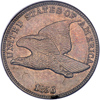 |
1856 Flying Eagle Cent. NGC graded Proof 62. Popular key date. Center dot under the top in the N in Cent. An admirable looking flying eagle cent, a beautiful Proof whose surface condition draws attention to itself and sporting a wallop from the dies that is amazingly close to complete. Original toning suggests that the present specimen spent some of its time in a coin envelope back in the good ol' days. If you collect this series of cents, then it is absolutely necessary that sometime in your life you'll have to step up to the line to acquire the rare, key date 1856 flying eagle cent. There's no shirking your duty. Any abrupt retreats now will cause your nerves to crack or your hair to fall out (if it hasn't already), so why not place a bid on this attractive Proof 62 cent today?
Estimated Value $13,000 - 15,000.
View details and enlarged photos
| Realized
$14,375 |
Lot 503 |
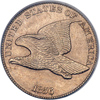 |
1856 Flying Eagle Cent. PCGS graded Proof 61. Popular key date. Light even toning on both sides. Another example of the fabled 1856 Flying Eagle cent, a date which was produced in both business strike and Proof formats. Whereas many examples were mishandled by the Washington notables who received them from the Mint, the present specimen was obviously well enough cared for since the time it left the coinage press that it has clean surfaces and choice rims. There are no readily apparent contact marks, and the surfaces have originally toned if somewhat muted light brown shades that heighten the appearance of the sharp eagle and wreath (PCGS # 2037) .
Estimated Value $12,000 - 14,000.
View details and enlarged photos
Check results on similar lots
| Realized
$13,513 |
Lot 504 |
 |
1861. PCGS graded Proof 65. Nicely toned. Eagle Eye sticker on this holder. A beautiful Gem toned example with frosted devices and moderately deep mirrors. None of the usual spots or flyspecks are present, making this an outstanding example of an exceptionally challenging date. As with the 1860 Indian cent Proofs, most coins struck this year were from moderately mirrored dies. This lack of deep proof finish at the Mint has made this difficult to locate in gem condition. Out on an original mintage of 1000 pieces, perhaps 400 were released. The number seen seems to be especially low, since substandard examples were subsequently spent, or included collections as business strikes.
There is enormous collector demand for the 1861 Indian cent in gem condition. Expect brutal competition for this magnificent piece. Pop 17; 2 in 66 (PCGS # 2256) .
Estimated Value $5,000 - 5,500.
View details and enlarged photos
Check results on similar lots
| Unsold |
Lot 505 |
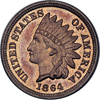 |
1864 Indian Head Cent. Copper-nickel. Proof 63 Plus. Nice bold strike with light lilac tones and some scattered light fly specks on both sides. A diminished impression is the usual outlook for a copper-nickel coin of this year, especially the business strikes, but in stark contrast, this choice Proof piece was left very boldly detailed by the recoil of the sharp dies; a fortunate occurrence. Notice the sharp definition in the feathers as well as the oak leaves in the wreath, etc.
Estimated Value $700 - 800.
View details and enlarged photos
| Unsold |
Lot 506 |
 |
1868 Indian Head Cent. PCGS graded MS-64 Red. Well struck with considerable mint red and some warm purple brown iridescence in the feathers. Struck with almost scientific precision at the feathers and feather ends, along with the wreath and shield. 1868 is, fortunately, one of the better made dates in the 1860s. Pop 52; 27 in 65RD; 3 in 66RD. (PCGS # 2093) .
Estimated Value $1,200 - 1,300.
View details and enlarged photos
Check results on similar lots
| Unsold |
Lot 507 |
 |
1869 Indian Head Cent. NGC graded MS-65 Red & Brown. Some mint red visable, the color waffling between flame red and deep crimson. A few stray marks. Pop 100; 20 in 66RB; none finer at NGC.
Estimated Value $950 - 1,050.
View details and enlarged photos
| Realized
$978 |
Lot 508 |
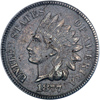 |
1877 Indian Head Cent. PCGS graded EF-45 Brown. An even medium brown, although it was probably buried; now lightly porous and marked up but still sharp for the grade. The key low-mintage date in the Indian cent series (PCGS # 2127) .
Estimated Value $2,000 - 2,200.
View details and enlarged photos
Check results on similar lots
| Unsold |
Lot 509 |
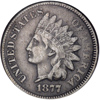 |
1877. NGC graded EF-40 Brown. Popular key date. Steel gray color with a few light marks in the feathers of the headdress. Choice rims (PCGS # 2127) .
Estimated Value $1,800 - 2,000.
View details and enlarged photos
Check results on similar lots
| Realized
$2,070 |
Lot 510 |
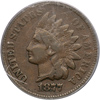 |
1877 Indian Head Cent. PCGS graded Fine-15 Brown. Popular key date. Only partial LIBERTY visible on hair ribbon, but the feathers are of at least Fine quality, as is the date and wreath. Light to medium brown. The scratches on the obverse are on the holder and not on the coin (PCGS # 2127) .
Estimated Value $1,100 - 1,200.
View details and enlarged photos
Check results on similar lots
| Unsold |
Lot 511 |
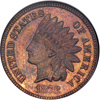 |
1878 Indian Head Cent. NGC graded MS-65 Red & Brown. Partial mint red with pleasing purple brown color. A well struck gem. Pop 80; 13 in 66RB.
Estimated Value $625 - 700.
View details and enlarged photos
| Realized
$604 |
Lot 512 |
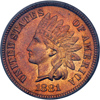 |
1881 Indian Head Cent. PCGS graded MS-65 Red. A fiery mint red gem. Old green holder. A blazing golden orange specimen whose rich rose and bright yellow highlights gleam at you with uncommon beauty. Sharp and appealing, and among the richest red examples of the grade certified by PCGS (PCGS # 2141) .
Estimated Value $800 - 900.
View details and enlarged photos
Check results on similar lots
| Unsold |
Lot 513 |
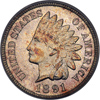 |
1891 Indian Head Cent. PCGS graded Proof 65 Red. Old green holder. Lovely rich mint color include swirls of pinkish-red luster with richer orange-red accents. Pop 14; 4 in 66 Red. (PCGS # 2362) .
Estimated Value $1,600 - 1,900.
View details and enlarged photos
Check results on similar lots
| Unsold |
Lot 514 |
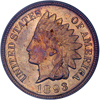 |
1893 Indian Head Cent. PCGS graded MS-65 Red. Deep autumnal shades of red, gold, and rose vie for dominance on this deeply colorful gem. Well struck, although not 100% complete on the feather ends (PCGS # 2186) .
Estimated Value $650 - 750.
View details and enlarged photos
Check results on similar lots
| Unsold |
Lot 515 |
 |
1904 Indian Head Cent. PCGS graded Proof 65 Red. Old green holder. Nice red colors. Even the finest, most delicate detail seen on this 1904 Proof struck with uncommon exactness for the issue. Bright orange-gold with warm red highlights as shown in the photographs. A Proof 65 gem that displays an endless amount of luster and physical strength. Pop 20; 5 in 66 Red; 1 in 67 Red. (PCGS # 2401) .
Estimated Value $600 - 700.
View details and enlarged photos
Check results on similar lots
| Realized
$863 |
Lot 516 |
|
1909-S Lincoln Cent. VDB. PCGS graded MS-65 Red. Popular key date. Brilliant, glossy, and very full original mint golden copper beginning to fade to natural orange. This is a nearly pristine coin of outstanding Gem quality, never dipped, improved, or enhanced in any way, but marvelous simply as is.
It is probably superfluous to discuss the pride one feels in owning one of the 1909-S V.D.B. cents, for its fame extends beyond the reach of all but a few 20th-century issues. Over the years the value of the '09-S V.D.B. has risen consistently. Today, gem MS65 Red pieces are as hard to come by as ever, what with recoloring and fly-by-night third- and fourth-tier grading firms. Truly high quality examples certified by a top-tier grader like PCGS are seen infrequently. The present piece remains as exciting as ever. Pop 699; 151 in 66 Red; 9 in 67 Red. (PCGS # 2428) .
Estimated Value $5,000 - 5,500.
View details
Check results on similar lots
| Realized
$5,865 |
Lot 517 |
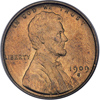 |
1909-S Lincoln Cent. VDB. PCGS graded MS-65 Red. Popular key date. Nice original mint red example. Sometimes on this issue, the devices that were left by the dies are short of the required precision due to weak die pressure, but we find the opposite to be the case here, everything is finely detailed, including the centers, with a clear bow tie, strong hair and beard. Therefore, a sharply struck Gem which has radiant rose, orange, and gold color. Pop 699; 151 in 66 Red; 9 in 67 Red. (PCGS # 2428) .
Estimated Value $5,000 - 5,500.
View details and enlarged photos
Check results on similar lots
| Unsold |
|
|